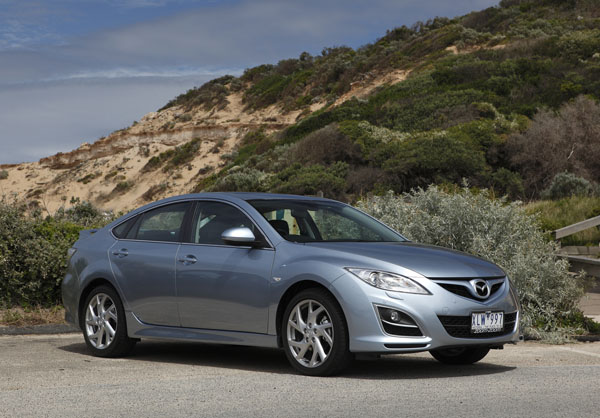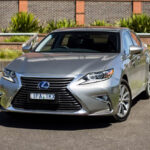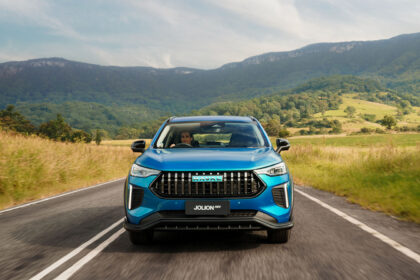Mazda6 was launched in Australia in August 2002 and has had sales success since day one. Probably because it was a lot more stylish than the Mazda 626 it replaced. The second generation arrived in February 2008 while the gen-three Mazda6 reached us downunder in December 2012 and again took automotive style to new levels.
Mazda6 has crept up in size and the latest model is not far short of Aurion, Commodore and Falcon in its dimensions.
These Mazdas have good handling, perhaps not quite to the highest European standards, but getting closer with each new model.
The extra quality of build offered by the Mazda over the European cars makes many buyers choose the Japanese model and it’s no surprise that Mazda is now the number one car importer in Australia.
Unusually for fully imported Japanese cars, Mazda6 was sold in three body types: sedan, hatch and station wagon. The third generation doesn’t have a hatch variant, but the wagon of that period is a cross between a hatch and a wagon and buyers of both types are going for it.
Not all model levels are offered in all body shapes. Mazda6 in Sports Hatch format, with a bold body kit, is one of our favourites, but there are plenty of others to choose from.
Four adults can be transported but may often have to compromise on legroom between front and back. The new model, sold from February 2008, has slightly more legroom in the rear, the 2012 model is larger than ever before and has decent rear legroom.
Back seat headroom in all models is good, though not overly generous due to the stylish slope of the roof. The station wagon has extra headspace over the back seat due to its extended roofline.
Mazda6 is powered by a four-cylinder petrol engine or a four-cylinder turbo-diesel.
The V6 option once offered in the Mazda 626 is not being offered, much to the disappointment of owners of the V6.
The original petrols had a 2.3-litre capacity, a new design of 2.5-litre four-cylinder engine was introduced with the Series 2 Mazda6 launched in 2008. An all-new unit using Mazda’s ground breaking SkyActiv technology makes the Series 3 an excellent drive.
Mazda was in the vanguard of Japanese makers with turbo-diesel engines in cars. A Mazda6 diesel was sold from October 2006. At that time it had a capacity of 2.0 litres, this was increased to 2.2 litres, with a corresponding increase in torque in the 2008 new-generation Mazda6.
Until 2012 the diesels came only with a six-speed manual gearbox, which probably explains why they haven’t proven particularly popular but make good country cars due to their long-range capability.
Transmission options in the Mazda6s with petrol engines were either a five-speed manual or four-speed tiptronic automatic. With the launch of the updated model in August 2005, these were improved by the addition of a six-speed manual or five-speed automatic. These transmission choices continued into the new model of 2008. From the Series 3 of December 2012 all have six-speed automatic transmissions.
An excellent model is the high-performance Mazda6 MPS, launched in October 2005. It has a turbocharged version of the 2.3-litre engine to give it plenty of oomph off the line. It was discontinued with the launch the second-generation Mazda6 series, a victim of its smaller, nimbler brother, the Mazda3 MPS.
The Mazda6 is a quite complex machine so it’s probably best if you leave servicing and repairs to the professionals. A good amateur mechanic will be able to do some work, but we recommend they stay away from safety related areas. Have a workshop manual at your elbow before getting started. Underbonnet access isn’t too bad.
Mazda has dealers in most areas of Australia. Obviously they aren’t common in the outback, but good communication back to head office can generally solve any unexpected problems.
Insurance costs are about average for a fully imported Japanese car and we know of no major company that charges an extra premium for the Sports Hatch.
WHAT TO LOOK FOR
Check that the engine starts promptly and settles into a steady idle within a few seconds of kicking over.
An automatic transmission that’s slow to go into gear, or that hunts up and down through the ratios could be due for a service, or a full overhaul.
A manual gearbox that’s reluctant to go into gear is also likely to need attention. Fast changes from third to second are often the first to play up.
Listen for a knocking noise from the universal joints inside the front wheels. Turn the steering wheel to full lock at very slow speeds to the right and the left and listen for the sound, a quiet car park is usually the best place to do this.
Check for crash repairs that haven’t been done correctly. These can lead to body rust and a weakening of the complete structure.
HOW MUCH?
Expect to pay from $4000 to $8000 for a 2002 Mazda6 Limited sedan; $7000 to $11,000 for a 2004 Classic wagon; $9000 to $14,000 for a 2006 Diesel sedan; $12,000 to $18,000 for a 2006 MPS sedan; $15,000 to $22,000 for a 2010 Limited sedan: $20,000 to $29,000 for a 2010 Luxury sedan; $28,000 to $39,000 for a 2012 Atenza sedan; and $34,000 to $46,000 for a 2013 Atenza wagon.
CAR BUYING TIP
Let your mind control your heart when it comes to buying any car, be it used or new.












